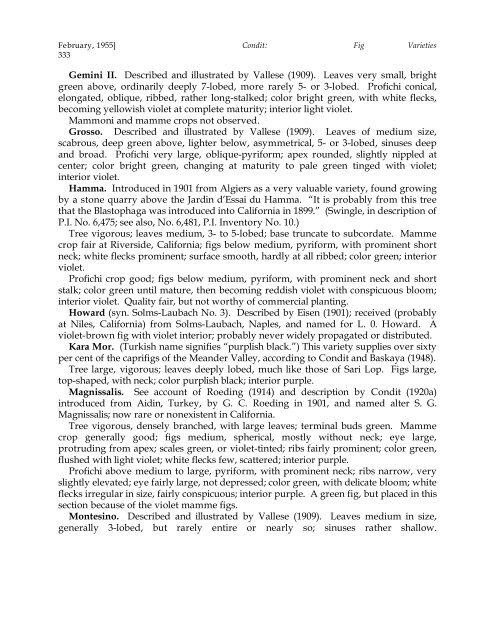Fig Varieties: A Monograph - uri=ucce.ucdavis
Fig Varieties: A Monograph - uri=ucce.ucdavis
Fig Varieties: A Monograph - uri=ucce.ucdavis
You also want an ePaper? Increase the reach of your titles
YUMPU automatically turns print PDFs into web optimized ePapers that Google loves.
February, 1955] Condit: <strong>Fig</strong> <strong>Varieties</strong><br />
333<br />
Gemini II. Described and illustrated by Vallese (1909). Leaves very small, bright<br />
green above, ordinarily deeply 7-lobed, more rarely 5- or 3-lobed. Profichi conical,<br />
elongated, oblique, ribbed, rather long-stalked; color bright green, with white flecks,<br />
becoming yellowish violet at complete maturity; interior light violet.<br />
Mammoni and mamme crops not observed.<br />
Grosso. Described and illustrated by Vallese (1909). Leaves of medium size,<br />
scabrous, deep green above, lighter below, asymmetrical, 5- or 3-lobed, sinuses deep<br />
and broad. Profichi very large, oblique-pyriform; apex rounded, slightly nippled at<br />
center; color bright green, changing at maturity to pale green tinged with violet;<br />
interior violet.<br />
Hamma. Introduced in 1901 from Algiers as a very valuable variety, found growing<br />
by a stone quarry above the Jardin d’Essai du Hamma. “It is probably from this tree<br />
that the Blastophaga was introduced into California in 1899.” (Swingle, in description of<br />
P.I. No. 6,475; see also, No. 6,481, P.I. Inventory No. 10.)<br />
Tree vigorous; leaves medium, 3- to 5-lobed; base truncate to subcordate. Mamme<br />
crop fair at Riverside, California; figs below medium, pyriform, with prominent short<br />
neck; white flecks prominent; surface smooth, hardly at all ribbed; color green; interior<br />
violet.<br />
Profichi crop good; figs below medium, pyriform, with prominent neck and short<br />
stalk; color green until mature, then becoming reddish violet with conspicuous bloom;<br />
interior violet. Quality fair, but not worthy of commercial planting.<br />
Howard (syn. Solms-Laubach No. 3). Described by Eisen (1901); received (probably<br />
at Niles, California) from Solms-Laubach, Naples, and named for L. 0. Howard. A<br />
violet-brown fig with violet interior; probably never widely propagated or distributed.<br />
Kara Mor. (Turkish name signifies “purplish black.”) This variety supplies over sixty<br />
per cent of the caprifigs of the Meander Valley, according to Condit and Baskaya (1948).<br />
Tree large, vigorous; leaves deeply lobed, much like those of Sari Lop. <strong>Fig</strong>s large,<br />
top-shaped, with neck; color purplish black; interior purple.<br />
Magnissalis. See account of Roeding (1914) and description by Condit (1920a)<br />
introduced from Aidin, Turkey, by G. C. Roeding in 1901, and named alter S. G.<br />
Magnissalis; now rare or nonexistent in California.<br />
Tree vigorous, densely branched, with large leaves; terminal buds green. Mamme<br />
crop generally good; figs medium, spherical, mostly without neck; eye large,<br />
protruding from apex; scales green, or violet-tinted; ribs fairly prominent; color green,<br />
flushed with light violet; white flecks few, scattered; interior purple.<br />
Profichi above medium to large, pyriform, with prominent neck; ribs narrow, very<br />
slightly elevated; eye fairly large, not depressed; color green, with delicate bloom; white<br />
flecks irregular in size, fairly conspicuous; interior purple. A green fig, but placed in this<br />
section because of the violet mamme figs.<br />
Montesino. Described and illustrated by Vallese (1909). Leaves medium in size,<br />
generally 3-lobed, but rarely entire or nearly so; sinuses rather shallow.















![Fig Trees in North Carolina [Archive] - IDigMyGarden ... - Figs 4 Fun](https://img.yumpu.com/26905320/1/190x245/fig-trees-in-north-carolina-archive-idigmygarden-figs-4-fun.jpg?quality=85)
